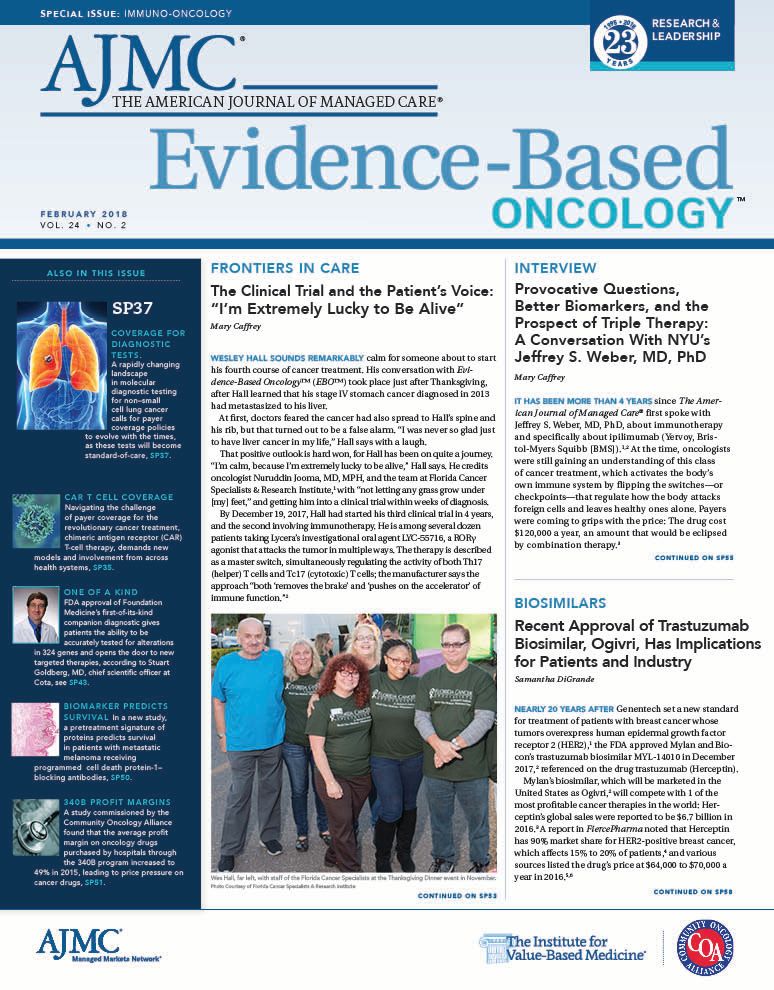- Center on Health Equity & Access
- Clinical
- Health Care Cost
- Health Care Delivery
- Insurance
- Policy
- Technology
- Value-Based Care
Future Shock: Embracing Disruption in the Immunotherapy Revolution
Dr Alvarnas is editor in chief and director of Value-Based Analytics at City of Hope, Duarte, California.
In 1970, futurist Alvin Toffler published his book, Future Shock, which explored the idea that the pace of change was accelerating well past the ability of people to assimilate this change.1 The resulting sense of displacement and disorientation was reflected in the book’s title.
We are now in a period of unprecedented rapid change in the domain of medical oncology. From emerging diagnostic technologies that leverage genomic, transcriptomic, and
proteomic assessments of germline and somatic cell mutations to the analogous expanding portfolio of targeted and immuno-oncologic (IO) agents, the very nature of cancer care is changing at a pace that is difficult, at best, to assimilate. As the opportunities for more effective diagnosis and treatment grow at a near-exponential rate, our ability to deliver these therapeutics effectively and efficiently to patients in need is proving to be an increasingly formidable challenge.
The quantum leap in cancer care from the triad of surgery/radiation therapy/chemotherapy toward a new era of therapeutics enriched by IO agents has created both systemic and patient-specific challenges. In a recent paper in the Annals of Oncology, the authors note:
“. . . (A)n unprecedented number of new investigational agents and companies are entering the field of IO. As such, it has become challenging for oncology physicians conducting clinical trials, industry veterans developing IO drugs, and even regulators reviewing novel IO agents to keep track of the rapidly evolving landscape.”2
These challenges also include the practical issues of how best to select patients for care using these agents, to the systems-based challenges of how best to deliver such highly complex care, at scale, in a financially sustainable way across the American healthcare system.3
The proliferation of highly effective targeted therapies has markedly altered the nature of care and outcomes for patients with historically poor prognosis cancers, such as late-stage lung cancer, who may benefit from the use of targeted IO agents, such as the checkpoint inhibitors. For patients with non—small cell lung cancer (NSCLC), the
5-year overall survival for patients responsive to checkpoint inhibitors has quintupled over that of historic controls.4
The potential of these agents to markedly improve patient outcomes is just one example of the potential of IO and targeted therapeutics to produce better care outcomes.
In this month’s edition of Evidence-Based Oncology™ (EBO™), we review the IO domain from perspectives ranging from that of the evolving standards of care for NSCLC to that of a patient who is undergoing IO treatment. Researchers from the Analysis Group review key changes in the evolving molecular/genomic diagnostic technologies that are
helping to change the prognosis for patients with NSCLC. In an interview, Jeffrey S. Weber, MD, PhD, provides his perspective on IO. And in a remarkable series of interviews, Mary Caffrey brings forth the voices of patients who have navigated the complexities of clinical trials related to immunotherapy. Their courage and resilience in the face of their
respective cancer journeys powerfully conveys the human dimensions of our evolving cancer armamentarium.
As the technologies at the heart of this new era of cancer diagnosis and therapeutics continue to evolve at a rate that is near impossible to assimilate, the challenges to cope with this emerging future will force us to grapple with the effects of our “future shock.” In conversations, such as those fostered by EBO™ amongst the respective cancer care
stakeholders, we hope to help ground the future in sustainable systems that are dedicated to ensuring the increasing efficiency, effectiveness, and equitability of these life-changing care technologies. References
1. Toffler A. Future Shock. New York, NY: Random House; 1970.
2. Tang J, Shalabi A, Hubbard-Lucy VM. Comprehensive analysis of the clinical immuno-oncology landscape. Ann Oncol. 2018;29(1):84-91. doi:
10.1093/annonc/mdx755.
3. Vermaelen K, Waeytens A, Kholmanskikh O, Van den Bulcke M, Van Valckenborgh E. Perspectives on the integration of immuno-oncology
biomarkers and drugs in a healthcare setting [published online November 21, 2017]. Semin Cancer Biol. doi: 10.1016/j.semcancer.2017.11.011.
4. Goodman A. Five-year survival quadrupled in responders to immunotherapy for non-small cell lung cancer. The ASCO Post. May 10, 2017.
ascopost.com/issues/may-10-2017/five-year-survival-quadrupled-in-responders-to-immunotherapy-for-non-small-cell-lung-cancer/.
Accessed February 6, 2018.

Exploring Racial, Ethnic Disparities in Cancer Care Prior Authorization Decisions
October 24th 2024On this episode of Managed Care Cast, we're talking with the author of a study published in the October 2024 issue of The American Journal of Managed Care® that explored prior authorization decisions in cancer care by race and ethnicity for commercially insured patients.
Listen
Integrated Care for Chronic Conditions: A Randomized Care Management Trial
December 3rd 2025The authors sought to understand the differential impact of payer-led community-based care management approaches on stakeholder-oriented outcomes for publicly insured adults with multiple chronic conditions.
Read More

